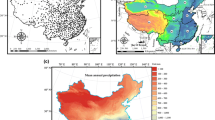Abstract
Satellite remote sensing deals with a complex system coupling atmosphere and surface. Any physical model with reasonable precision needs several to tens of parameters. Without a priori knowledge of these parameters, Proposition 3 of Verstraete et al. requires the number of independent observations to be greater than the number of unknown parameters. This requirement can hardly be satisfied even in the coming EOS era. As Tarantola pointed out, the inversion problems in geoscience are always underdetermined in some sense. In order to make good use of every kind of a priori knowledge for effectively extracting information from remote sensing observations, the right question to set is as follows:Given an imperfect model and a certain amount ofa priori information on model parameters, in which sense should one modify thea priori information, given the actual observation with noise?A priori knowledge of physical parameters can be presented in different ways such as physical limits, global statistical means and variance fora certain landcover type, or previous statistics and temporal variation of a specific target. When sucha priori knowledge can be expressed as joint probability density. Bayessian theorem can be used in the inversion to obtain posterior probability densities of parameters using newly acquired observations. There is no prerequirement on how many independent observations must be made, and the knowledge gained merely depends on the information content of the new observations. Some specific problems about knowledge accumulation and renewal are also discussed.
Similar content being viewed by others
References
Li Xiaowen, Ni Wenge, Fusion of multiangular and imaging spectrometer data, inProc. of GIS, AM/ FM Asia’ 97 &Geoinformatics’ 97, Taipei, 1997, 349–353.
Li Xiaowen, Wang Jindi,Canopy Reflectance Models, Inversion, and Characterization of Canopy Structure (inChinese), Beijing:Science Press, 1995, 118.
Iaquinta, J., Pinty, B., Privette, J. L., Inversion of a physically based bidirectional reflectance model of vegetation,IEEE Trans. on Geosciense and Remote Sensing, 1997, 35(3):687.
Yu Tao, Tian Guoliang, The application of the thermal inertia method for monitoring of soil moisture of North China plain based on NOAA-AVHRR data,Journal of Remote Sensing (inChinese), 1997, 1(1):24.
Jin Yaqiu, Liu Changlong, Parameter retrieval by using ANN model,Journal of Remote Sensing (in Chinese), 1997, 1(2):83.
Verstraete, M. M., Pinty, B., Myneny, R. B., Potential and limitations of information extraction on the terrestrial biosphere from satellite remote sensing,Remote Sensing Environment, 1996, 58:201.
Li Xiaowen, Wang Jindi, Multiangular remote sensing and its application, inRemote Sensing in China (inChinese), Beijing:Surveying Press, 1996, 325–328.
Li, X., Yan, G., Liu, Y. et al., Uncertainty and sensitivity matrix of parameters in inversion of physical BRDF model,Special Issue of Journal of Remote Sensing of the First International Workshop on Multiangular Remote Sensing, 1997, 1(suppl.):113.
Tarantola, A.,Inverse Problem Theory-Methods for Data Fitting and Model Parameter Estimation, Amsterdan:Elsevier, 1987.
Neapolitan, R. E.,Probabilistic Reasoning in Expert System-Theory and Algorithms, New York:John Wiley & Sons, 1990, 433.
Li, X. W., Strahler, A. H., Geometric-optical bidirectional reflectance modeling of mutual shadowing effects of crown in a forest canopy,IEEE Trans. on GARS, 1992, 30(2):276.
Wan, Z., Li, Z., A physics-based algorithm for retrieving land-surface emissivity and temperature from EOS/MODIS data,IEEE Trans. on Geoscience and Remote Sensing, 1997, 4(35):980.
Author information
Authors and Affiliations
Additional information
Project supported partially by the National Natural Science Foundation of China (Grant Nos. 49671059, 49771058). China’s National Key Basic Research Plan 863 Project, NAS 5-31369 of NASA, USA, Vegetation Programme of EC, and ESCAP joint program of NASDA, Japan.
Rights and permissions
About this article
Cite this article
Li, X., Wang, J., Hu, B. et al. On utilization ofa priori knowledge in inversion of remote sensing models. Sci. China Ser. D-Earth Sci. 41, 580–585 (1998). https://doi.org/10.1007/BF02878739
Received:
Issue Date:
DOI: https://doi.org/10.1007/BF02878739




